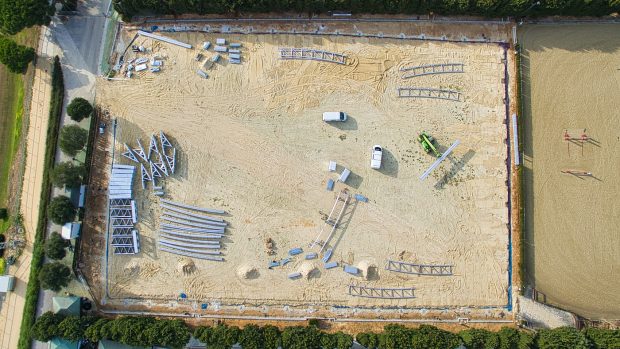When building an arena, choosing the right surface is vital. Here is a summary of some of the most common surfaces available and what they are pros and cons of each
Wood chip and fibre chip
Wood fibre is produced especially for equestrian surfaces and usually consists of smaller particles, whereas wood chip can be anything out of a timber merchant’s chipper. The particle size of wood chip is important. If the pieces are too large it will not settle and can become lodged in hooves; if the pieces are too small and lightweight they may blow around in the wind. Wood-based surfaces are eco-friendly if not treated with chemicals or colourings. Recycled wood, however, should be treated with caution since it could contain old nails, wire or staples from a previous life as a kitchen unit, door, window frame or pallet. Don’t be tempted to do a DIY job. Cheap timber offcuts will break down quickly, can block drainage, splinter or become slippery. A wood-based surface is less prone to freezing than sand, depending on the quality of wood and bark content. A surface that doesn’t contain bark will last longer and will not absorb as much water.
Best for: wood chip and wood fibre can be used for indoor or outdoor arenas as well as other equestrian surfaces — gallops, lungeing rings, turn-out paddocks and horse-walkers. They are also suitable for all disciplines.
What you should know: of all the arena surfaces, wood chip and wood fibre are the least durable and have the shortest lifespan. Another disadvantage of wood chip is that it can become slippery when it dries out, so it needs regular watering. If the drainage conditions are not good, the arena can also become waterlogged.
Life expectancy: a good quality wood fibre outdoor arena, given correct maintenance, should have a life expectancy of between four and 10 years, depending on usage. In a busy riding school the surface would not be expected to last more than eight years. Wood chip has a similar life expectancy, depending on the type of wood. However, it is not necessary to buy a new surface every few years; a top-up layer can be added.
Rubber chips
A longer lasting alternative to wood chip or fibre is small pieces of rubber chip. A rubber-based surface requires less maintenance, and is less likely to become waterlogged or dry out. A big advantage of rubber surfaces is that they do not freeze: frozen arenas can be a major problem for owners, who often want to ride early on winter mornings and could lose valuable riding time for days. Rubber is dust-free and is unlikely to blow around in a strong wind. But while it’s good for outdoor arenas it is not generally recommended for indoor use. In hot summers, the surface can heat up, producing an unwelcome odour. The most important point about rubber surfaces is they cannot be used entirely on their own. They need a base, and sand, ideally silica sand, is best. Finally, rubber is probably the most comfortable surface to fall off on to.
Best for: outdoor arenas, particularly for jumping, since it is less likely to result in skidding when horses land or concussion injuries.
What you should know: if you want to change your arena surface in the future, rubber is not biodegradable and may be expensive to get rid of.
Life expectancy: pretty much indestructible if maintained according to manufacturers’ guidelines, such as keeping the surface levelled.
Sand and sand mixes
Sand was traditionally very popular, but nowadays more people are using a combination, such as sand with a topping of rubber or a sand-mixed product. Sand used for arenas is silica sand, which is natural but more durable than most. Europe is leading the field in developing new sand mixes and UK companies have picked up on the trend for more equine friendly substances. Among the latest products are those that mimic the binding ability of topsoil to improve the surface quality and minimise kickback. Horses can travel on top of this type of surface rather than moving through it.
Best for: good for galloping. Many all-weather racetracks are sand-based.
What you should know: sand starts the “emery board effect” as soon as it is laid, with the natural process of grinding against itself. Through the action of hooves, it gradually gets finer, becoming progressively deeper. Also, sand alone is not an all-weather surface and can freeze in winter. If your surface is unwaxed, it will need to be watered during dry weather for optimum performance.
Life expectancy: usually a minimum of five years.
Price range: you could cover a 20x40m arena with silica sand for a few hundred pounds.
Waxed surfaces and coatings
Surfaces that have been treated with a wax coating, usually sand mixed with synthetic fibres, have particles that bind together more effectively and there is less surface movement. They need less maintenance than their unwaxed counterparts.
The more sophisticated products have been developed to emulate turf as closely as possible, allowing for “bounce” and absorption of impact.
This feature was first published in Horse & Hound (6 October 2005)



